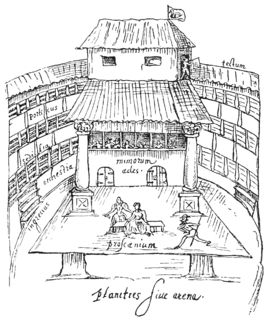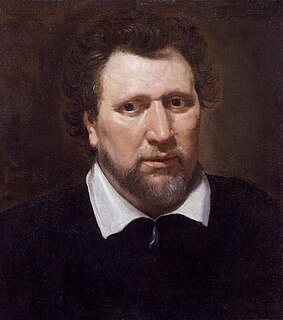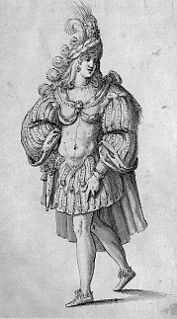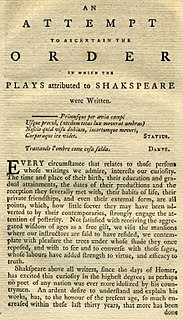
The Oxfordian theory of Shakespeare authorship contends that Edward de Vere, 17th Earl of Oxford, wrote the plays and poems of William Shakespeare. While historians and literary scholars overwhelmingly reject alternative authorship candidates, including Oxford, public interest in the Oxfordian theory continues. Since the 1920s, the Oxfordian theory has been the most popular alternative Shakespeare authorship theory.

English Renaissance theatre, also known as Renaissance English theatre and Elizabethan theatre, refers to the theatre of England between 1558 and 1642.

Benjamin Jonson was an English playwright and poet. Jonson's artistry exerted a lasting influence upon English poetry and stage comedy. He popularised the comedy of humours; he is best known for the satirical plays Every Man in His Humour (1598), Volpone, or The Fox, The Alchemist (1610) and Bartholomew Fair (1614) and for his lyric and epigrammatic poetry. "He is generally regarded as the second most important English dramatist, after William Shakespeare, during the reign of James I."

Thomas Middleton was an English Jacobean playwright and poet. He, with John Fletcher and Ben Jonson, was among the most successful and prolific of playwrights at work in the Jacobean period, and among the few to gain equal success in comedy and tragedy. He was also a prolific writer of masques and pageants.

The masque was a form of festive courtly entertainment that flourished in 16th- and early 17th-century Europe, though it was developed earlier in Italy, in forms including the intermedio. A masque involved music and dancing, singing and acting, within an elaborate stage design, in which the architectural framing and costumes might be designed by a renowned architect, to present a deferential allegory flattering to the patron. Professional actors and musicians were hired for the speaking and singing parts. Often the masquers, who did not speak or sing, were courtiers: the English queen Anne of Denmark frequently danced with her ladies in masques between 1603 and 1611, and Henry VIII and Charles I of England performed in the masques at their courts. In the tradition of masque, Louis XIV of France danced in ballets at Versailles with music by Jean-Baptiste Lully.

William Shakespeare (1564–1616) wrote sonnets on a variety of themes. When discussing or referring to Shakespeare's sonnets, it is almost always a reference to the 154 sonnets that were first published all together in a quarto in 1609. However, there are six additional sonnets that Shakespeare wrote and included in the plays Romeo and Juliet, Henry V and Love's Labour's Lost. There is also a partial sonnet found in the play Edward III.
This article contains information about the literary events and publications of 1611.
This article contains information about the literary events and publications of 1605.

This article presents a possible chronological listing of the composition of the plays of William Shakespeare.

George Chapman was an English dramatist, translator and poet. He was a classical scholar whose work shows the influence of Stoicism. Chapman has been speculated to be the Rival Poet of Shakespeare's sonnets by William Minto, and as an anticipator of the metaphysical poets of the 17th century. Chapman is best remembered for his translations of Homer's Iliad and Odyssey, and the Homeric Batrachomyomachia.

John Marston was an English playwright, poet and satirist during the late Elizabethan and early Jacobean periods. His career as a writer lasted only a decade. His work is remembered for its energetic and often obscure style, its contributions to the development of a distinctively Jacobean style in poetry, and its idiosyncratic vocabulary.

The Shakespeare apocrypha is a group of plays and poems that have sometimes been attributed to William Shakespeare, but whose attribution is questionable for various reasons. The issue is separate from the debate on Shakespearean authorship, which addresses the authorship of the works traditionally attributed to Shakespeare.
The War of the Theatres is the name commonly applied to a controversy from the later Elizabethan theatre; Thomas Dekker termed it the Poetomachia.

Ben Jonson collected his plays and other writings into a book he titled The Workes of Benjamin Jonson. In 1616 it was printed in London in the form of a folio. Second and third editions of his works were published posthumously in 1640 and 1692.
Oberon, the Faery Prince was a masque written by Ben Jonson, with costumes, sets and stage effects designed by Inigo Jones, and music by Alfonso Ferrabosco and Robert Johnson. Oberon saw the introduction to English Renaissance theatre of scenic techniques that became standard for dramatic productions through the coming centuries.
Pleasure Reconciled to Virtue is a Jacobean era masque, written by Ben Jonson and designed by Inigo Jones. It was first performed on Twelfth Night, 6 January 1618, in the Banqueting House at Whitehall Palace. The work's failure on its initial performance, and its subsequent revision, marked a significant development in Jonson's evolving masque technique.
Pan's Anniversary, or The Shepherd's Holiday was a Jacobean era masque, written by Ben Jonson and designed by Inigo Jones. The date of the masque's performance at the English Court has long been in dispute: while the earliest text assigns it to 1625, mid-twentieth-century scholars placed it on 19 June 1620, the king's birthday, at the royal palace at Greenwich. More recently, Martin Butler has argued for a date of 6 January 1621.

As You Like It is a pastoral comedy by William Shakespeare believed to have been written in 1599 and first published in the First Folio in 1623. The play's first performance is uncertain, though a performance at Wilton House in 1603 has been suggested as a possibility.

The Shakespeare authorship question is the argument that someone other than William Shakespeare of Stratford-upon-Avon wrote the works attributed to him. Anti-Stratfordians—a collective term for adherents of the various alternative-authorship theories—believe that Shakespeare of Stratford was a front to shield the identity of the real author or authors, who for some reason—usually social rank, state security, or gender—did not want or could not accept public credit. Although the idea has attracted much public interest, all but a few Shakespeare scholars and literary historians consider it a fringe theory, and for the most part acknowledge it only to rebut or disparage the claims.
The Tragical History of Guy Earl of Warwick or The Tragical History, Admirable Atchievments and Various Events of Guy Earl of Warwick is an English history play, with comedy, of the late 16th or early 17th century. The author of Guy Earl of Warwick is not known, although Ben Jonson and Thomas Dekker have been proposed. The play is about the adventures of legendary English hero Guy of Warwick in Europe and the Holy Land, and about the relationship between Guy and his wife, Phillis. Guy Earl of Warwick is notable because one of the characters - Guy's servant and comic sidekick Philip Sparrow - is considered by some scholars to be an early lampoon of William Shakespeare.














